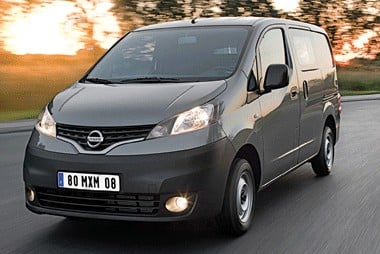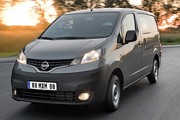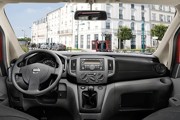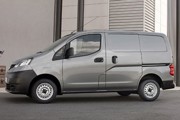Review
On the face of it, Nissan has one of the best light commercial vehicle ranges of any manufacturer in the UK.
There’s the diminutive Kubistar, the Primastar medium panel van, the Interstar heavweight, the class-leading Navara, the down-to-earth yet aging NV300 truck and the timeless – and very popular – Cabstar.
But in spite of this stunning array, Nissan has never really achieved what many would see as its full fleet sales potential.
One of the problems is that Kubistar is a rebadged Renault Kangoo, while Primastar is a recycled Renault Trafic/Vauxhall Vivaro and Interstar, apart from its moniker, is a Renault Master/Vauxhall Movano.
And while Vauxhall and Renault are very much geared up for big fleet business, Nissan has largely remained the domain of the one-man band.
But things are about to change. Within five years, Nissan plans to have largely cut its LCV ties with Renault by launching six new models, all styled in its own unique fashion rather than being clones of the French maker.
First off the blocks is the van on test here, the NV200, which goes on sale in the UK this month and will go head-to-head with the likes of the Citroën Berlingo, Volkswagen Caddy and Ford Transit Connect. Next year we’ll be seeing a new 3.5-tonner.
Both will be based on Nissan platforms, although the NV200 will sport Renault’s ubiquitous 1.5 dCi diesel powerplant. A 1.6-litre petrol engine will be offered outside the UK, while a Combi version with five or seven seats joins the UK line-up in February.
Corporate sales director Tony Lewis is fresh in the job after being recruited from LDV – and he’s all set to crank up Nissan’s fleet credentials.
He said the firm had 185 dealers in total, of which 54 have been designated as LCV specialists. In addition, Nissan LCVs are sold through six Volvo truck dealerships. These dealers have made additional investment in people, facilities and service and will be able to offer expertise both before and after a sale is made.
Lewis said the NV200 was a truly sector-breaking van that focused on cargo space, value and comfort. He said: “From the B pillar forwards it’s a car and after that it’s a van.”
This year, Lewis aims to sell just 491 NV200s, rising to 2,000 in 2010 and 3,000 in 2011.
One model will be available, with E and SE grades. E features ABS brakes as standard, along with electronic brake distribution, driver airbag, one-third bulkhead, manual windows and immobiliser. SE adds electric windows and mirrors, keyless entry, a full bulkhead and driver’s seat height adjustment.
Various option packs will offer air conditioning, a reversing camera and rear glazed doors, while ESP traction control will be a paid-for option. The NV200’s real strength comes in its size.
Although it looks like a standard small van, it offers a load volume of 4.2 cubic metres – more than in the old Citroën Dispatch – and has a tight turning circle for urban manoeuvring but will carry two Europallets.
Load length is 2,040mm while height is 1,358mm, which should make this van of interest to those converters who make wheelchair-accessible vehicles.Gross vehicle weight, meanwhile, is 2,000kg, while payload is a respectable 752kg.
The Renault engine hardly needs any introduction as it graces most of the French maker’s cars and vans.
It offers 85bhp at 3,750rpm and 147lb-ft of torque at 2,000rpm, while offering 54.3mpg on the combined cycle and emitting 137g/km of CO2. Prices will be revealed later this month.
Behind the wheel
First glance of the NV200 shows it to be very much a Japanese product. It looks more than a trifle odd at first. But, then, didn’t we all laugh at the “Postman Pat” looks of the Citroën Berlingo when launched? And consider how normal it looks today.
But whatever the looks, there’s no doubt that this van truly breaks all the old segment rules – it’s a small van that has big van capabilities.
My only reservation on the exterior is that there isn’t a lot of padding on the outside to soak up any annoying knocks and scrapes.
Inside, the driver’s seat is perched up high, which means that for multi-drop users, getting in and out is very easy. It gives excellent views of the road ahead and makes the NV200 feel bigger than it really is.
The passenger seat folds down to allow extra cargo space and there’s also a little desk on the back, which should prove useful now that white van man is expected to carry out all sorts of other tasks.
A variety of bulkheads are available – including a meshed one which swivels round in the middle so the driver is still protected when long loads are carried.
Sidewall padding and a rubber floor will be extra, although a sliding side door comes as standard and another can be added at a cost. There are the usual four load-lashing eyes and the rear doors split 60/40.
Renault’s familiar dCi unit fires up smoothly and without fuss and a slick dash-mounted gearlever ensures smooth changes.
Our test vans came with half a load on board but on the road I felt the power steering was a little on the light side. But there’s no faulting the NV200’s excellent road manners.
The 85bhp on tap is plenty to ferry this van a long nicely and I’m glad to see that Nissan won’t be offering any performance versions that some manufacturers seem to delight in.
Having said that, the van wasn’t exactly a ball of fire on some of the steep inclines, although it never threatened to give up altogether.
The standard fitting of ABS brakes gets the thumbs up from Fleet Van but it’s a shame Nissan couldn’t have really made this van really stand out by making ESP traction control standard too, as with the Ford Transit Connect.
Verdict
It’s a tough time to be launching a new van into an even tougher sector. But the NV200 can hold its head up against any of the
opposition – it’s now down to Nissan’s salesmen to persuade Britain’s big fleet buyers to abandon their Citroëns, Fords and Vauxhalls.






















